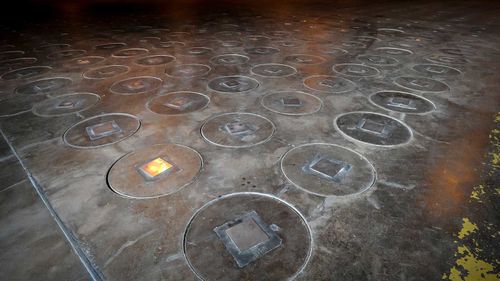<div class="block-content"><div class="styles__Container-sc-1ylecsg-0 goULFa"><span>Workers at a site in South Carolina that once made key parts for nuclear bombs in the US have found a radioactive wasp nest but officials said there is no danger to anyone.</span></div></div><div class="block-content"><div class="styles__Container-sc-1ylecsg-0 goULFa"><span>Employees who routinely check radiation levels at the Savannah River Site near Aiken found a wasp nest on July 3 on a post near tanks where liquid nuclear waste is stored, according to a report from the US Department of Energy.</span></div></div><div class="block-content"><div class="styles__Container-sc-1ylecsg-0 goULFa"><span>The nest had a radiation level 10 times what is allowed by federal regulations, officials said.</span></div></div><div><div id="adspot-mobile-medium"></div></div><div class="block-content"><div class="styles__Container-sc-1ylecsg-0 goULFa"><strong><span>READ MORE:</span></strong><span> </span><a href="https://www.9news.com.au/health/france-health-study-microplastics/6e8fccaa-54a0-4aa6-bf71-08588b26b53d" target="_blank"><strong><span>New study claims we're breathing in tens of thousands of harmful microplastics every day</span></strong></a></div></div><div class="block-content"><div class="styles__Container-sc-1ylecsg-0 goULFa"><span>The workers sprayed the nest with insect killer, removed it and disposed of it as radioactive waste. No wasps were found, officials said.</span></div></div><div class="block-content"><div class="styles__Container-sc-1ylecsg-0 goULFa"><span>The report said there is no leak from the waste tanks, and the nest was likely radioactive through what it called “onsite legacy radioactive contamination” from the residual radioactivity left from when the site was fully operational.</span></div></div><div class="block-content"><div class="styles__Container-sc-1ylecsg-0 goULFa"><span>The watchdog group Savannah River Site Watch said the report was at best incomplete since it doesn't detail where the contamination came from, how the wasps might have encountered it and the possibility there could be another radioactive nest if there is a leak somewhere.</span></div></div><div><div class="OUTBRAIN" data-reactroot="" data-src="//www.9news.com.au/world/radioactive-wasp-nest-found-at-site-where-us-once-made-nuclear-bombs/ee93af04-dcc0-4283-aaee-f0e338146d15" data-widget-id="AR_5"></div></div><div class="block-content"><div class="styles__Container-sc-1ylecsg-0 goULFa"><span>Knowing the type of wasp nest could also be critical — some wasps make nest out of dirt and others use different material which could pinpoint where the contamination came from, Tom Clements, executive director of the group, wrote in a text message.</span></div></div><div class="block-content"><div class="styles__Container-sc-1ylecsg-0 goULFa"><span>“I’m as mad as a hornet that SRS didn’t explain where the radioactive waste came from or if there is some kind of leak from the waste tanks that the public should be aware of,” Clements said.</span></div></div><div class="block-content"><div class="styles__Container-sc-1ylecsg-0 goULFa"><span>The tank farm is well inside the boundaries of the site and wasps generally fly just a few hundred yards from their nests, so there is no danger they are outside the facility, according to a statement from Savannah River Mission Completion which now oversees the site.</span></div></div><div class="block-content"><div class="styles__Container-sc-1ylecsg-0 goULFa"><span>If there had been wasps found, they would have significantly lower levels of radiation than their nests, according to the statement which was given to the Aiken Standard.</span></div></div><div class="block-content"><div class="styles__Container-sc-1ylecsg-0 goULFa"><span>The site was opened in the early 1950s to manufacture the plutonium pits needed to make the core of nuclear bombs during the start of the Cold War with the Soviet Union. Now the site has shifted toward making fuel for nuclear plants and clean up.</span></div></div><div class="block-content"><div class="styles__Container-sc-1ylecsg-0 goULFa"><span>The site generated more than 625 million litres of liquid nuclear waste which has, through evaporation, been reduced to about 129 million litres, according to Savannah River Mission Completion.</span></div></div><div class="block-content"><div class="styles__Container-sc-1ylecsg-0 goULFa"><span>There are still 43 of the underground tanks in use, while eight have been closed.</span></div></div><div class="block-content"><div class="styles__Container-sc-1ylecsg-0 goULFa"><a href="https://www.9news.com.au/national/how-to-follow-9news-digital/29855bb1-ad3d-4c38-bc25-3cb52af1216f" target="_blank"><strong><em><span>DOWNLOAD THE 9NEWS APP</span></em></strong></a><strong><em><span>: Stay across all the latest in breaking news, sport, politics and the weather via our news app and get notifications sent straight to your smartphone. Available on the</span></em></strong><span> </span><a href="https://apps.apple.com/au/app/9news/id1010533727" target="_blank"><strong><em><span>Apple App Store</span></em></strong></a><span> </span><strong><em><span>and</span></em></strong><span> </span><a href="https://play.google.com/store/apps/details?id=nineNewsAlerts.nine.com&hl=en_AU&pli=1" target="_blank"><strong><em><span>Google Play</span></em></strong></a><strong><em><span>.</span></em></strong><span></span></div></div>
Radioactive wasp nest found at site where US once made nuclear bombs

Leave A Reply
Your email address will not be published.*